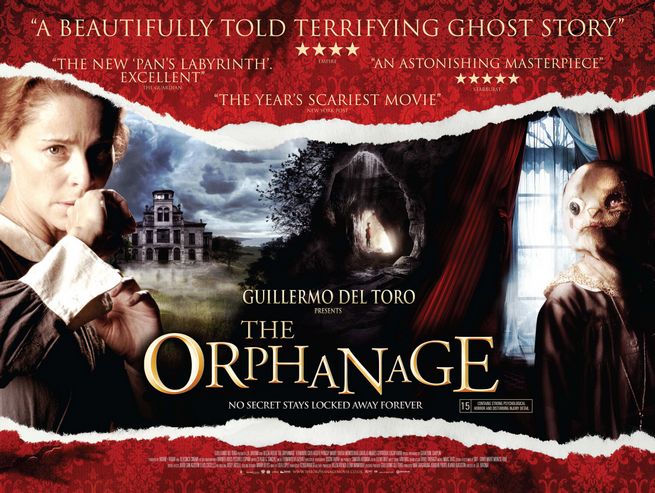
Nick posted his reaction to El orfanato a couple of months back and now that I’m teaching the film, I’d like to expand on his comments about one of the best films of the year in UK distribution. The DVD of the film offers a rich mixture of extras and commentaries which help to explain the director’s approach – and why it was so enthusiastically ‘presented’ by Guillermo del Toro. Del Toro’s name on the credits helps to sell the film in the US and UK, but it is a little misleading in terms of audience expectations. El orfanato is much more closely connected to Spanish cinema history/influences than El laberinto del fauno, even though the latter refers more directly to Spanish history. The different box office careers of the films are interesting – in Spain, El orfanato was the much bigger success, grossing over €24 million and taking top box office position for the year (by comparison, Pan’s Labyrinth took under €8 million). In the US, the fortunes of the films were reversed with Pan’s Labyrinth taking five times more at the box office ($37million to $7million). In the UK, Pan’s Labyrinth took slightly more. Overall, the figures show a very successful pair of films, which are both Spanish-language productions with a focus on children in various genre mixes that involve horror and fairy tales. The difference between the other genre repertoires involved in the mix is the means of separating them.
Perhaps the most interesting essay on El orfanato that I have read was published in Sight and Sound, April 2008. Maria Delgado situates El orfanato in terms of the lost children and families from the Spanish Civil War, making the observation that it is only within the last year that the Spanish government has finally passed legislation that allows families to finally come to terms with their losses:
Spain’s Law of Historical Memory was finally passed by José Luis Rodríguez Zapatero’s socialist government late last year, with the result that the bodies of between 30,000 and 150,000 civilians who opposed the right-wing Nationalists during the Civil War and its aftermath can be exhumed from the mass graves in which they are believed to lie. The Orphanage adeptly explores the legacy of a buried past.
Delgado references a wide range of films in her persuasive account of how El orfanato is so deeply embedded within Spanish film culture. I haven’t seen all the films she mentions, but certain links – to Alejandro Amenábar’s The Others and to both The Spirit of the Beehive and Cría cuervos (Raise Ravens) are ones that struck me straight away. The last two titles both feature Ana Torrent, then aged 6 and 8 respectively. She made her name with these two films, becoming a child star right at the end of Franco’s domination of Spanish culture – when children were venerated in cinema and society at large. Both films were critiques of fascism presented in highly ambiguous metaphors. In Cría cuervos, Ana is a little girl who believes she has murdered her father – motivated by her mother’s death for which she thinks her father was responsible. (The father was an Army Officer and Ana’s family offers a kind of microcosm of Spain under Franco.) Ana’s mother is played by Geraldine Chaplin (director Carlos Saura’s wife) and she also plays the older Ana who is later revealed to be telling the story in flashback. In El orfanato, Geraldine Chaplin plays the ‘spirit medium’ who Simón’s mother hires when he goes missing.
None of these references will mean much outside Spain, but they clearly had resonances for sections of the Spanish audience. Some other aspects of the plot offer more universal symbols associated with 20th century wars – e.g. human remains hidden in ovens.
The extracts I have been using during an event analysing El orfanato are:
The Innocents (UK 1961)
The Others (Spain/US 2001)
Dark Water (Japan 2002)
Kilómetro 31 (Mexico 2006)
What has struck me most is the repetition of quite specific elements across several films. For instance, drawings of ghosts by children occur in The Ring (US 2002), The Others, Dark Water and El orfanato. Children’s games such as hide and seek or ‘grandmother’s footsteps’ appear in The Innocents, Dark Water and El orfanato etc.
I’ll try to add to this over the next few weeks.
In the meantime, here’s a useful fansite reference:
I watched this movie quite recently (http://cliched-monologues.blogspot.com/2008/08/orphanage-el-orphanto-2007.html), and I must admit I did like the movie despite the not-so-new basic plot structure. What made the movie good weren’t the chill or thrill factors, rather the elements of drama and human stories. Though it never attains the brilliance attained by its producer Del Toro in Pan’s Labyrinth and Devil’s Backbone, its still an appreciable venture. Perhaps an important reason for that would be Bayona never attempted to impersonate or imitate Del Toro. Consequently this is very much his film despite the presence of his charismatic producer.
Very insightful discussion of The Orphanage, which IMHO is one of the best ghost stories ever created for the big screen (along with The Others). I also thank you for mentioning Kilómetro 31, a movie I did not yet have on my growing list of supernatural horror films. I look forward to reading more of your thoughts on horror movies.
I have always been an obsessive listmaker, and my compulsion du jour is horror; I have quite a movie list going now. I use it when I shop for used DVDs to help me remember what I am looking for and what a fair price might be for a given flick. I would be happy to share this list with a fellow horror fan and blogger — it represents dozens of hours of research — if you are interested. It is an Excel spreadsheet.
Take care
S